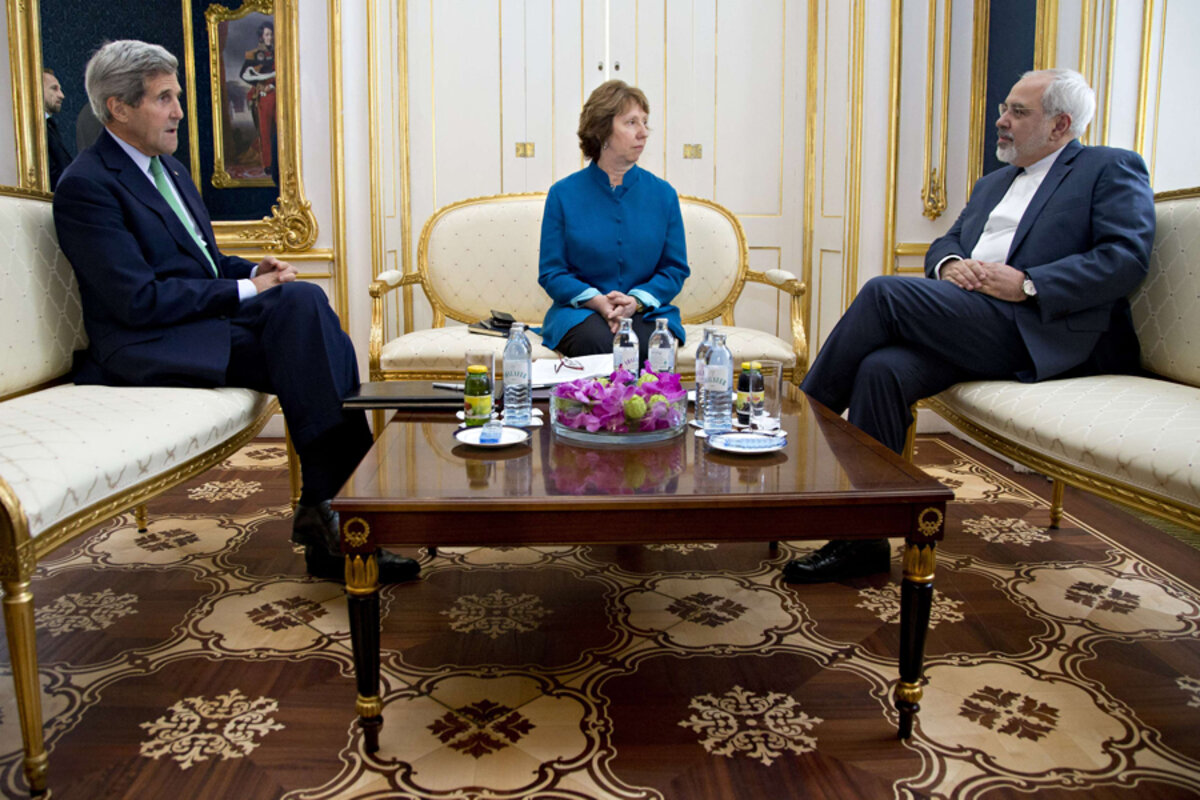Iran nuclear talks: Parties officially upbeat, but is failure an easier sell?
Loading...
| Tehran, Iran
US and Iranian negotiators are putting on a brave face during a new round of nuclear talks in Vienna this week, with positions still far apart despite years of haggling and less than six weeks before a deadline to strike a deal.
Top diplomats sought to raise hopes that failure was not imminent, at least, in talks that aim to ensure Iran’s nuclear program will never produce a weapon.
But few are predicting success either, as Iran and the so-called P5+1 group continue declaring as they have for months that it is the other side that must make hard choices.
The crux is finding an acceptable balance between dialing back and capping Iran’s capacity to enrich uranium, and easing US, EU, and UN sanctions that have crippled Iran’s economy.
This round of talks in Vienna is “crucial, because it tells if there is a way forward, or what the options are,” says Ali Vaez, the senior Iran analyst for the Brussels-based International Crisis Group think tank.
“The parties still have the same amount of political will to get an agreement, [and know] this is a unique opportunity, but they simply can’t figure out a formula that is mutually acceptable,” says Mr. Vaez, speaking in Istanbul.
The result is that both side’s minimum requirements “don’t overlap,” says Vaez. “From an Iranian perspective, the price is simply not right.”
Both US and Iranian administrations have invested substantial political and diplomatic capital in a deal, and stared down critics, up until a landmark interim deal was signed in Geneva last November, and since.
But, paradoxically, as the Nov. 24 deadline approaches, both Iran and the US – thanks to virulent opposition to any deal among noisy hard-line minority factions in Tehran and Washington – may be able to sell collapse more easily at home.
“Today as things stand, failure is easy to manage for the Rouhani administration,” Vaez says, referring to Iran’s centrist president, Hassan Rouhani. “They can go back and simply say, ‘The West had excessive demands, we didn’t give up, we resisted’… But success is more difficult to sell, because they have to explain very painful concessions that are inevitable if they want to get a deal.”
Opposing demands
Iran wants all sanctions lifted, though only a suspension of the most biting measures appears to be on the table – meaning the move can be quickly reversed anytime by the P5+1 group: the US, Russia, China, Britain, France, and Germany.
The P5+1 also wants Iran to make significant cuts in the 19,000 centrifuges it has installed, though only half now operate. Iran may accept some temporary lowering, but envisions an active research program and eventually a far larger industrial scale program than it has now.
“The fact that there are eye-catching disputes does not mean they can’t be resolved,” Iranian Foreign Minister Mohammad Javad Zarif told Iranian media. The fact that an initial two days of talks have been extended to a third day, Thursday, doesn’t mean anything “positive or negative has occurred.”
US Secretary of State John Kerry struck a similar note. “I don’t believe it’s out of reach, but we have some tough issues to resolve,” he said Tuesday. Pundits who predicted failure, he said, “know more than I do.”
“We keep chipping away,” a senior US official in Vienna said Wednesday. “In places gaps have narrowed, but the Iranians have some fundamental decisions to make.”
Ayatollah Khamenei's 'red lines'
Such decisions may be constrained by the 11 “red lines” issued this week by Iran’s supreme leader, Ayatollah Ali Khamenei, in the form of a graphic. A year ago he coined the term “heroic flexibility” as the nuclear talks progressed. But Mr. Khamenei has also frequently disparaged the talks as unlikely to reach a deal, and the graphic shows how he is publicly shaping a much more expansive outcome for Iran.
The graphic said Iran’s nuclear science “should not come to a halt or even slow down;” that no one can “bargain over” Iran’s nuclear achievements; and that Iran’s negotiating team “should not accept any impositions” from the P5+1.
It also said Iran’s “final need” to fuel its own nuclear reactors is an enrichment capacity nearly 20 times the current level. Such figures do not feature in the current talks, though a critical sticking point is how many years the deal will impose its restrictions.
And yet this week, President Rouhani said a nuclear deal was “certainly” within reach.
“There will not be an agreement that will be acceptable to all in Iran, the US won’t accept that,” says Mojtaba Mousavi, the editor of the IransView website, speaking in Tehran.
“I don’t think the Americans will agree to a good deal, and if we are obligated to conditions, it will be worse for us,” says Mr. Mousavi.
And the aftermath, if the talks fail? “This is what the Rouhani government is thinking about, day and night.”





